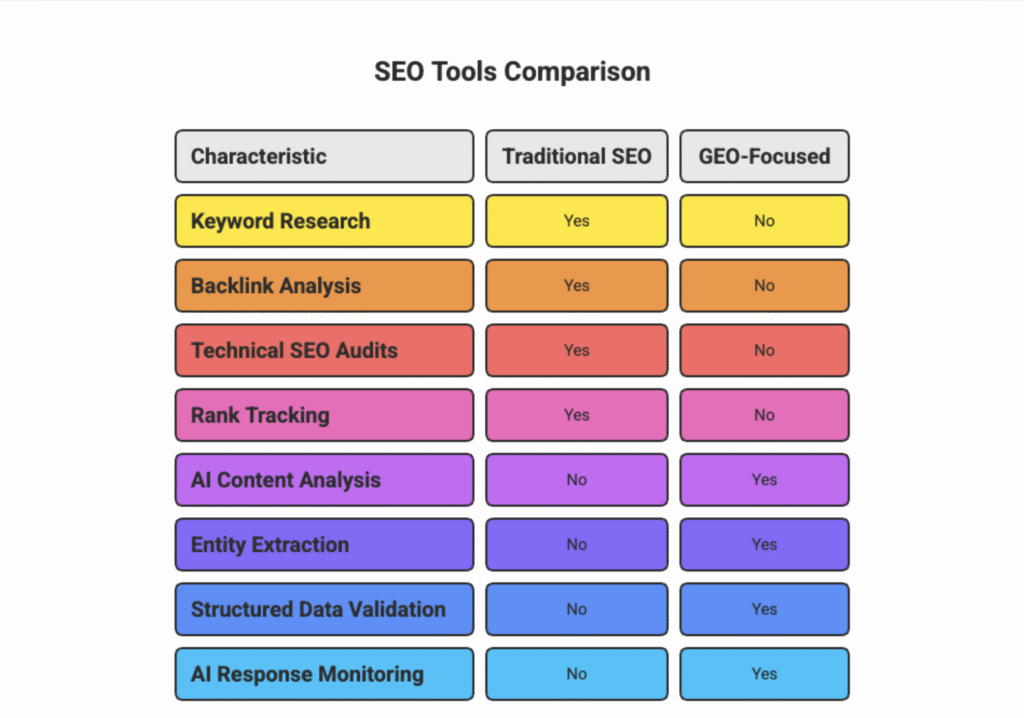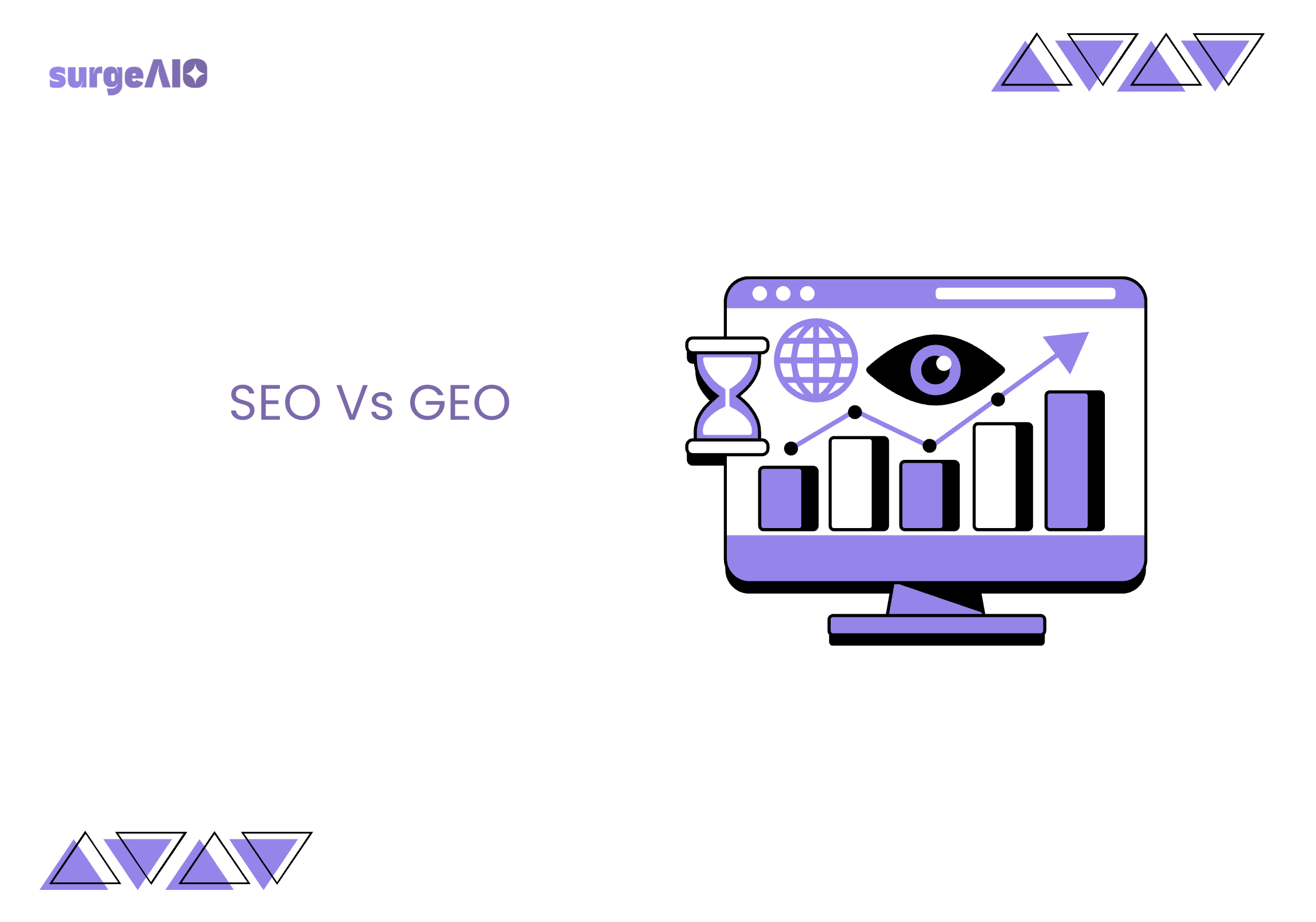The digital marketing landscape is experiencing a seismic shift that’s forcing businesses to rethink their entire approach to online visibility.
While Search Engine Optimization (SEO) has been the cornerstone of digital marketing for over two decades, a new challenger has emerged: Generative Engine Optimization (GEO).
This comprehensive guide explores both strategies, their differences, and why understanding both is crucial for your business’s success.
Understanding the Digital Revolution
68% of online experiences begin with a search engine, making search optimization one of the most critical aspects of digital marketing.
However, the way people search and consume information is rapidly evolving. Almost 70% of companies use SEO strategy and get about 5 times the return (ROI) for every dollar they spend, but the emergence of AI-powered search tools is changing the game entirely.
The rise of AI assistants like ChatGPT, Google’s AI Overviews, and Perplexity has introduced a new paradigm where users get instant, synthesized answers instead of clicking through to websites.
This shift has created the need for Generative Engine Optimization – a strategy that ensures your content gets featured in AI-generated responses.
What is SEO? A Deep Dive into Traditional Search Optimization
Search Engine Optimization (SEO) is the time-tested practice of improving your website’s visibility on traditional search engines like Google, Bing, and Yahoo. It’s about climbing the rankings to appear higher on search result pages when users type in relevant queries.
Core Elements of SEO
1. Keyword Research and Optimization
- Identifying terms your target audience searches for
- Strategic placement throughout content
- Long-tail keyword targeting for niche audiences
2. Technical SEO
- Site speed optimization
- Mobile-friendliness
- SSL certificates and security
- XML sitemaps and robots.txt files
3. Content Quality and Depth
- Comprehensive, valuable content
- Regular updates and fresh information
- User-focused writing that answers search intent
4. Link Building
- Earning high-quality backlinks
- Internal linking strategies
- Building domain authority through credible sources
How SEO Works: The Traditional Three-Stage Process
- Crawling: Search engines use bots to discover content by following links across the web
- Indexing: Discovered content is processed and stored in massive databases
- Ranking: Content is ranked based on over 200 factors including relevance, authority, and user experience
The result? Your website appears in search results at a position determined by how well it satisfies these ranking factors compared to competing content.
SEO Statistics That Matter
53.3% of all website traffic comes from organic searches, highlighting the continued importance of SEO. Additionally:
- Google maintains a web index of ~400 billion documents and processes an estimated 3.5 billion searches each day
- 15% of all Google searches have never been searched before
- Mobile devices account for 59.91% of global search engine market share
Also Read: What is AEO in SEO? Answer Engine Optimization in 2025
What is GEO? The Future of Search Optimization
Generative Engine Optimization (GEO) focuses on optimizing content for AI-powered search tools that don’t just list links but synthesize answers from multiple sources and deliver them conversationally.
Unlike traditional search results, GEO outcomes are generated dynamically and can vary based on user context, prompting, and platform behavior.
Core Elements of GEO
1. Content Structure and Clarity
- Using simple, direct language AI can easily interpret
- Organizing content with clear headings and bullet points
- Creating scannable, extractable information
2. Authority and Accuracy
- Providing source-backed information
- Demonstrating expertise through comprehensive coverage
- Building trust through consistent, factual content
3. Entity Optimization
- Clearly defining people, places, and concepts
- Using structured data markup
- Creating relationships between entities
How GEO Works: The AI-Driven Approach
- Content Ingestion: AI systems continuously absorb web content through pre-training or real-time retrieval
- Knowledge Extraction: AI identifies key facts, entities, and relationships within content
- Relevance Assessment: AI determines which sources contain the most relevant, reliable information
- Response Generation: AI synthesizes information, potentially citing your content if it meets quality standards
The fundamental difference: SEO relies on ranking signals to determine position in a list, while GEO relies on information quality and structure to determine inclusion in synthesized answers.
SEO vs GEO: A Complete Comparison
| Aspect | SEO (Search Engine Optimization) | GEO (Generative Engine Optimization) |
| Definition & Purpose | Enhance website visibility and ranking on traditional search engines to drive organic traffic | Optimize content for inclusion and accuracy in AI-powered generative engine responses |
| Target Platforms | Google, Bing, Yahoo, and other traditional search engines | ChatGPT, Bard, Perplexity, Google AI Overviews |
| Ranking Method | Algorithm-based on 200+ factors including keywords, backlinks, technical SEO | AI extraction and synthesis capabilities based on content quality and structure |
| Optimization Focus | Keywords, backlinks, technical SEO, user experience signals | Content structure, E-E-A-T principles, comprehensive coverage |
| Key Metrics | Organic traffic, keyword rankings, click-through rate (CTR), backlink quality | Inclusion in AI responses, response accuracy, citation frequency |
| Content Focus | In-depth, keyword-rich content designed to match search intent | Direct, scannable answers that AI can easily interpret and deliver |
| User Behavior | Click-through to website for full information | Information consumption directly in AI responses |
| Traffic Source | Direct website visits from search results | Citations and references in AI responses |
| Update Frequency | Algorithm updates (quarterly/yearly) | Model training updates (continuous) |
The Evolution of Search Behavior
29% of marketers list SEO as a top trend they leverage, while 13% of marketers use voice search optimization in their marketing strategy. This shift indicates a growing recognition of diverse search methods.
The statistics reveal changing user behavior:
- 20.5% of the global population used voice search in Q2 of recent measurements
- Mobile searches now account for 58% of all searches, while desktop falls to 40%
- AI-powered search tools are gaining millions of users monthly
Key Differences in Strategy and Implementation
Content Creation Approach
SEO Content Strategy:
- Focus on keyword density and placement
- Long-form content for comprehensive coverage
- Internal and external linking strategies
- Meta descriptions and title tag optimization
GEO Content Strategy:
- The most effective approach combines fluency optimization with adding statistics to the text
- Clear, concise statements of fact
- Structured information with headers and lists
- Entity-rich content with defined relationships
Technical Considerations
SEO Technical Requirements:
- Page speed optimization
- Mobile responsiveness
- SSL certificates
- XML sitemaps
- Schema markup for rich snippets
GEO Technical Requirements:
- Structured data for AI understanding
- Clear content hierarchy
- Accessible information architecture
- JSON-LD markup for entities
The Strategic Integration: Why Both Matter
GEO is changing the search landscape, but it’s not replacing SEO entirely. The smartest approach involves integrating both strategies for maximum visibility across all search channels.
Shared Foundation: Quality Content
Both SEO and GEO benefit from:
- Content Depth: Comprehensive content serves both ranking algorithms and AI extraction
- E-E-A-T Principles: Expertise, experience, authoritativeness, and trustworthiness benefit both strategies
- User Value: Content that genuinely helps users performs well in both traditional and AI search
Dual-Purpose Optimization Techniques
- Strategic Content Structure
- Clear H2s and H3s help with SEO readability while creating perfect extraction points for AI
- FAQ sections satisfy featured snippet potential while providing direct answers AI can reference
- Structured data enhances SEO through rich results while making information more parsable for AI
- Practical Implementation Steps
- Audit existing high-performing SEO content for GEO optimization opportunities
- Expand keyword research to include natural language questions AI users ask
- Cross-channel measurement tracking both search rankings and AI citations
Industry Expert Perspectives
The digital marketing community is divided on the urgency of GEO adoption. Some experts believe GEO is the new SEO, while others see it as a complementary strategy. However, there’s growing consensus that ignoring GEO could lead to decreased visibility as AI search tools gain popularity.
As one industry analyst noted, “The businesses that thrive in 2025 and beyond won’t be the ones with the biggest budgets or the longest-running SEO campaigns. They’ll be the adaptable ones who recognize new opportunities and seize them before their competition.”
Platform-Specific Strategies
Google’s Evolving Landscape
Google’s introduction of AI Overviews represents a hybrid approach, combining traditional search results with AI-generated summaries. This creates opportunities for content to appear in both traditional rankings and AI summaries.
ChatGPT and Conversational AI
Traditional SEO techniques like high keyword density are ineffective or even counterproductive in the context of GEO. Generative engines prioritize contextual relevance and natural language processing.
Emerging Platforms
Perplexity, Bing Chat, and other AI search tools each have unique algorithms and preferences, requiring tailored optimization strategies.
Measuring Success: KPIs and Analytics
SEO Metrics
- Organic traffic growth
- Keyword ranking improvements
- Click-through rates
- Backlink acquisition
- Technical SEO scores
GEO Metrics
- AI citation frequency
- Response accuracy rates
- Brand mention in AI outputs
- Query coverage in AI responses
- User engagement with AI-cited content
Common Pitfalls and How to Avoid Them
SEO Mistakes That Hurt GEO
- Keyword stuffing that reduces readability
- Overly complex content structure
- Neglecting entity relationships
- Focusing solely on search engine algorithms
GEO Mistakes That Ignore SEO
- Over-simplifying content
- Neglecting traditional ranking factors
- Ignoring user experience on actual websites
- Abandoning proven SEO strategies
Tools and Resources for Success
For businesses looking to excel in both SEO and GEO, SurgeAIO.com offers cutting-edge tools that can streamline your optimization efforts. The platform provides AI-powered content analysis that evaluates your content through both SEO and GEO lenses, helping you identify opportunities for dual optimization.
Essential Tool Categories

The Future of Search: 2025 and Beyond
The search landscape will likely become increasingly diverse, with multiple platforms serving different user needs. 13.5% of SEO professionals stated that content strategy and production will be their number one focus area in 2024, indicating a shift toward content quality over manipulation tactics.
Predicted Trends
- Increased AI Integration: More search engines will incorporate AI-generated results
- Voice Search Growth: Conversational queries will become more prevalent
- Personalization: AI will deliver increasingly personalized search results
- Multimodal Search: Visual and audio search will require new optimization strategies
Practical Implementation Guide
Phase 1: Assessment and Planning
- Audit current SEO performance
- Analyze content for GEO potential
- Identify key competitors in both spaces
- Set measurable goals for both strategies
Phase 2: Content Optimization
- Restructure existing high-performing content for AI extraction
- Create new content with dual optimization in mind
- Implement structured data markup
- Optimize for featured snippets and AI citations
Phase 3: Monitoring and Iteration
- Track performance across both SEO and GEO metrics
- Adjust strategies based on platform changes
- Scale successful techniques across all content
- Stay updated with algorithm and model changes
Expert Recommendations
Industry leaders suggest starting small with GEO implementation. Take one high-performing SEO page and optimize it for AI extraction by adding clearer entity relationships and structuring facts more explicitly. This approach allows you to test effectiveness without overhauling your entire content strategy.
The integration of tools like those available on SurgeAIO.com can significantly accelerate this process, providing insights that would take hours to generate manually.
Frequently Asked Questions
How much should I budget for GEO compared to SEO?
GEO typically requires 20-30% less budget than traditional SEO since it focuses more on content restructuring rather than expensive link building campaigns. While SEO budgets often include significant costs for backlink acquisition, technical audits, and multiple tool subscriptions, GEO optimization primarily involves content analysis and restructuring.
However, businesses should allocate budget for AI content analysis tools and monitoring platforms. A balanced approach might involve 60% SEO budget and 40% GEO budget, with the ratio shifting toward GEO as AI search adoption increases.
Can small businesses compete with large corporations in GEO?
Actually, yes! GEO levels the playing field more than traditional SEO. Large corporations often dominate SEO through massive budgets for backlinks and technical resources.
However, GEO prioritizes content quality, accuracy, and structure over domain authority. A small business with expertly crafted, well-structured content about their niche can get cited in AI responses alongside or instead of larger competitors.
This makes GEO particularly attractive for local businesses and specialized service providers who can demonstrate clear expertise in their field.
How long does it take to see results from GEO optimization?
GEO results can appear much faster than SEO results. While SEO typically takes 3-6 months to show significant ranking improvements, GEO optimized content can start appearing in AI responses within 2-4 weeks after implementation.
This is because AI models continuously update their knowledge base, and well-structured, authoritative content gets recognized quickly.
However, consistency in AI citations may take 2-3 months to establish. The key advantage is that once your content is recognized by AI systems, it tends to maintain visibility more consistently than traditional search rankings.
What happens to my SEO investment if GEO becomes dominant?
Your SEO investment isn’t wasted – it’s foundational. Many SEO elements like content quality, technical website health, and authority building directly benefit GEO performance. Well-optimized websites are more likely to be crawled and trusted by AI systems.
However, tactical adjustments are needed: keyword-stuffed content may need restructuring, and link-building strategies should focus on authoritative sources rather than volume. Think of it as evolution, not replacement – your SEO foundation supports GEO success.
Are there any industries where GEO is less effective than SEO?
Yes, certain industries benefit more from traditional SEO. E-commerce businesses still need SEO for product discovery and transaction-focused searches, since users typically want to visit actual stores.
Local businesses requiring immediate action (emergency services, restaurants) benefit more from traditional local SEO with map listings.
Additionally, industries with frequently changing information (real estate, job listings, live events) may find SEO more effective since AI responses can become outdated. Visual-heavy industries (photography, design, fashion) also rely more on traditional search and social discovery than text-based AI responses.
Conclusion
The debate between SEO vs GEO misses the fundamental point: this isn’t an either-or decision. The most successful businesses in 2025 will be those that master both traditional search optimization and generative engine optimization.
The generative engine optimization (GEO) is the new wing of digital marketing, but it’s building on the foundation established by decades of SEO evolution. Companies that embrace both strategies will capture visibility across all search channels, from traditional Google results to AI-powered conversational interfaces.
The key is to start now. While your competitors debate which strategy to choose, begin implementing both. Optimize your content structure for AI extraction while maintaining the SEO fundamentals that drive website traffic. Use tools and platforms like SurgeAIO.com to streamline the process and gain competitive advantages.
Remember, the future belongs to businesses that adapt quickly to technological changes. SEO taught us the importance of search visibility; GEO is teaching us the importance of information authority. Master both, and you’ll be prepared for whatever the search landscape brings next.
The question isn’t whether to choose SEO or GEO – it’s how quickly you can integrate both strategies to dominate search visibility in all its evolving forms. The businesses that understand this distinction will be the ones that thrive in the AI-driven future of search.


